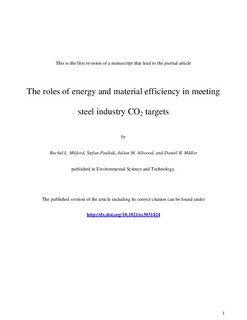| dc.contributor.author | Milford, Rachel | |
| dc.contributor.author | Pauliuk, Stefan | |
| dc.contributor.author | Allwood, Julian | |
| dc.contributor.author | Müller, Daniel B. | |
| dc.date.accessioned | 2014-04-22T07:58:38Z | |
| dc.date.accessioned | 2016-06-10T10:15:32Z | |
| dc.date.available | 2014-04-22T07:58:38Z | |
| dc.date.available | 2016-06-10T10:15:32Z | |
| dc.date.issued | 2013 | |
| dc.identifier.citation | Environmental Science and Technology 2013, 47(7):3455-3462 | nb_NO |
| dc.identifier.issn | 0013-936X | |
| dc.identifier.uri | http://hdl.handle.net/11250/2392193 | |
| dc.description.abstract | Identifying strategies for reducing greenhouse gas emissions from steel production requires a comprehensive model of the sector but previous work has either failed to consider the whole supply chain or considered only a subset of possible abatement options. In this work, a global mass flow analysis is combined with process emissions intensities to allow forecasts of future steel sector emissions under all abatement options. Scenario analysis shows that global capacity for primary steel production is already near to a peak and that if sectoral emissions are to be reduced by 50% by 2050, the last required blast furnace will be built by 2020. Emissions reduction targets cannot be met by energy and emissions efficiency alone, but deploying material efficiency provides sufficient extra abatement potential. | nb_NO |
| dc.language.iso | eng | nb_NO |
| dc.publisher | American Chemical Society | nb_NO |
| dc.title | The Roles of Energy and Material Efficiency in Meeting Steel Industry CO2 Targets | nb_NO |
| dc.type | Journal article | nb_NO |
| dc.date.updated | 2014-04-22T07:58:38Z | |
| dc.description.version | submittedVersion | |
| dc.source.pagenumber | 3455-3462 | nb_NO |
| dc.source.volume | 47 | nb_NO |
| dc.source.journal | Environmental Science and Technology | nb_NO |
| dc.source.issue | 7 | nb_NO |
| dc.identifier.doi | 10.1021/es3031424 | |
| dc.identifier.cristin | 1018068 | |
| dc.description.localcode | This document is the unedited author's version of a Submitted Work that was subsequently accepted for publication in Environmental Science and Technology , copyright © American Chemical Society after peer review. To access the final edited and published work see http://pubs.acs.org/doi/abs/10.1021/es3031424 | nb_NO |
